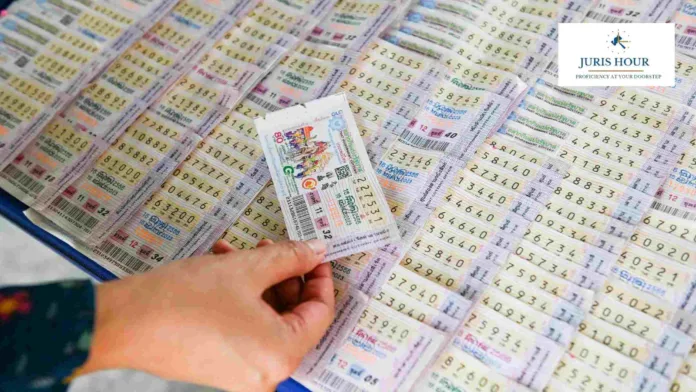Kerala publishes monthly/yearly lottery charts that list winning numbers for every draw — handy to verify tickets or track past results. If you win, lottery prize money in India is taxed heavily: a flat 30% on the prize (special tax on windfalls) plus surcharge (if applicable) and health & education cess (4%) on the tax — and TDS is normally deducted before you get paid.
What the “Kerala Lottery Monthly Chart” is — and where to get it
- The monthly chart is a compact table showing the winning numbers (first-prize and key prize categories) for each draw day of a month or year. It’s published by official Kerala lottery portals and mirrored on several result sites — useful for quick checks and historical lookups.
- Official downloads and the prize-claim forms are available from the Kerala State Lotteries website (forms, claim procedure, timelines). Always cross-check any third-party site against the official page.
How to read the chart (quick)
- Find the draw date and lottery name (e.g., Karunya, Akshaya, Win-Win).
- Check the first-prize number(s) listed for that date — that’s the main winner.
- Charts often show second/third prizes and consolation numbers in adjacent columns. Use the chart to cross-verify your 6-digit ticket number.
Prize-claim basics (what winners must do)
- Sign the back of your winning ticket immediately and keep the original safe. Do not laminate or alter the ticket.
- Small prizes (≤ ₹10,000): local agent or designated counters can pay them; carry ID and the original ticket. Prizes > ₹10,000: submit Form V and supporting ID, PAN and bank copy; larger prizes may need submission at the Directorate and additional verification. Claim timeframes and exact documents are on the state site.
Tax law: the legal basis (short)
- Lottery and similar windfall winnings are taxed separately under the Income-tax law (special provisions such as Section 115BB). They attract a flat 30% tax (this is not the regular slab system).
- TDS (Tax Deducted at Source) on winnings is governed by the TDS provisions (Section 194B): organizers/deductors normally deduct tax at source at 30% (plus surcharge & cess where applicable).
What actually gets deducted — TDS, surcharge & cess (how it’s calculated)
- Basic tax: 30% of the full prize amount.
- Surcharge: levied on the tax amount (not on the prize). Surcharge rates depend on the size of your total income(for big wins this matters) — commonly: > ₹50 lakh to ₹1 crore → 10% of tax, > ₹1 crore to ₹2 crore → 15% of tax, etc. (official tables available).
- Health & Education Cess: 4% on (tax + surcharge).
Important (Budget 2025 change): TDS is applied per single transaction when the prize exceeds ₹10,000 (the rule was clarified in Budget 2025 — aggregate threshold removed). That means for a single prize > ₹10,000 the payer will usually deduct TDS at source.
Example calculations (step-by-step) — realistic take-home figures
(illustrative — assumes payer/deductor follows the law and deducts TDS including surcharge and cess where applicable)
Method:
- Basic tax = prize × 30%
- Surcharge = basic tax × surcharge rate (0% / 10% / 15% depending on slab)
- Tax + surcharge = basic tax + surcharge
- Cess = 4% × (tax + surcharge)
- Total withheld = (tax + surcharge + cess)
- Net paid = prize − total withheld
Examples
| Prize (₹) | Basic tax (30%) | Surcharge | Cess (4% on tax+surcharge) | Total tax withheld | Net paid (approx.) |
| 10,000 | 3,000 | 0 | 120 | 3,120 | 6,880 (note: if prize is ≤ ₹10,000, TDS may not be withheld but tax still due in return). |
| 5,00,000 | 1,50,000 | 0 | 6,000 | 1,56,000 | 3,44,000. |
| 1,00,00,000 (₹1 crore) | 30,00,000 | 3,00,000 (10% of tax) | 1,32,000 | 34,32,000 | 65,68,000 net. (surcharge taken as 10% of tax because prize falls in the >₹50L–≤₹1Cr bracket for this example). |
Note: The payer should ideally deduct surcharge on the tax (not on the prize). The final tax/cess amounts depend on the exact surcharge slab that applies to your total income in the year — very large combined income can push surcharge higher. Always confirm with your tax advisor.
TDS vs. final tax liability — what to watch for
- TDS is an advance tax: if the payer deducts TDS (say 30% or 31.2% including cess), you will get Form 16A / TDS certificate. When you file your Income-Tax Return, the actual tax on your total income is computed. For lottery income the law treats that income under special provisions (flat 30%); you still must report it in ITR.
- If PAN is not provided to the deductor, tax may be deducted at a higher rate under Section 206AA (the higher of specified rate or 20% rule) — so always give PAN and link Aadhaar as required.
Practical tips if you win (quick checklist)
- Sign the back of the ticket immediately; keep the original safe — do not laminate.
- Photograph the ticket (front + back) and keep copies of buyer’s receipt.
- Gather ID, PAN, bank passbook copy and the Form V (for prizes > ₹10,000) before visiting the lottery office or bank.
- Get help from a chartered accountant before claiming very large prizes — they’ll advise on documentation, whether to receive payment via bank, and on post-tax investment or tax planning.
- If you don’t want the prize amount in a single lump sum or face documentation issues, consult legal/tax counsel — but the tax law on prize income is rigid (flat tax).
Final words
- The Kerala Lottery Monthly Chart is an easy reference for winners and watchers — always cross-check with official state lottery pages.
- If you win: expect the government to take a big chunk — plan ahead, submit your PAN, and get professional tax help for large prizes. The headline takeaway: a flat 30% tax + surcharge (if any) + 4% cess means the actualtake-home on very large wins can be roughly 60–70% of the gross prize (depending on surcharge slab).
Read More: Living Expenses In UK Per Month In 2025

